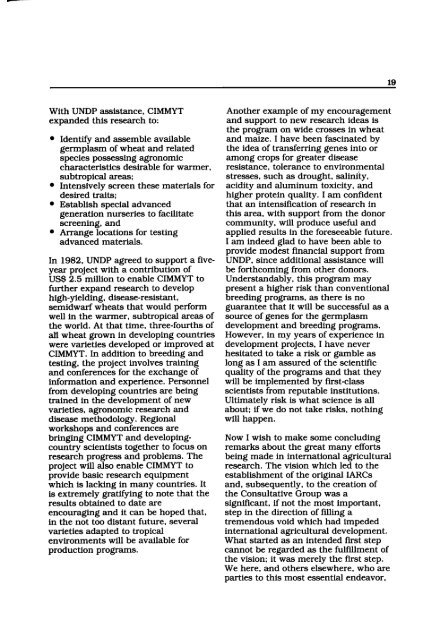the Symposium on Wheats for More Tropical Environments - cimmyt
the Symposium on Wheats for More Tropical Environments - cimmyt
the Symposium on Wheats for More Tropical Environments - cimmyt
- No tags were found...
You also want an ePaper? Increase the reach of your titles
YUMPU automatically turns print PDFs into web optimized ePapers that Google loves.
19With UNDP assistance. CIMMYTexpanded this research to:• Identify and assemble availablegermplasm of wheat and relatedspecies possessing agr<strong>on</strong>omiccharacteristics desirable <strong>for</strong> warmer.subtropical areas;• Intensively screen <str<strong>on</strong>g>the</str<strong>on</strong>g>se materials <strong>for</strong>desired traits;• Establish special advancedgenerati<strong>on</strong> nurseries to facilitatescreening. and• Arrange locati<strong>on</strong>s <strong>for</strong> testingadvanced materials.In 1982. UNDP agreed to support a fiveyearproject with a c<strong>on</strong>tributi<strong>on</strong> ofUS$ 2.5 milli<strong>on</strong> to enable CIMMYT tofur<str<strong>on</strong>g>the</str<strong>on</strong>g>r expand research to develophigh-yielding. disease-resistant.semidwarf wheats that would per<strong>for</strong>mwell in <str<strong>on</strong>g>the</str<strong>on</strong>g> warmer. subtropical areas of<str<strong>on</strong>g>the</str<strong>on</strong>g> world. At that time. three-fourths ofali wheat grown in developing countrieswere varieties developed or improved atCIMMYT. In additi<strong>on</strong> to breeding andtesting. <str<strong>on</strong>g>the</str<strong>on</strong>g> project involves trainingand c<strong>on</strong>ferences <strong>for</strong> <str<strong>on</strong>g>the</str<strong>on</strong>g> exchange ofin<strong>for</strong>mati<strong>on</strong> and experience. Pers<strong>on</strong>nelfrom developing countries are beingtrained in <str<strong>on</strong>g>the</str<strong>on</strong>g> development of newvarieties. agr<strong>on</strong>omic research anddisease methodology. Regi<strong>on</strong>alworkshops and c<strong>on</strong>ferences arebringing CIMMYT and developingcountryscientists toge<str<strong>on</strong>g>the</str<strong>on</strong>g>r to focus <strong>on</strong>research progress and problems. Theproject will also enable CIMMYT toprovide basic research equipmentwhich is lacking in many countries. Itis extremely gratifying to note that <str<strong>on</strong>g>the</str<strong>on</strong>g>results obtained to date areencouraging and it can be hoped that.in <str<strong>on</strong>g>the</str<strong>on</strong>g> not too distant future. severalvarieties adapted to tropicalenvir<strong>on</strong>ments will be available <strong>for</strong>producti<strong>on</strong> programs.Ano<str<strong>on</strong>g>the</str<strong>on</strong>g>r example of my encouragementand support to new research ideas is<str<strong>on</strong>g>the</str<strong>on</strong>g> program <strong>on</strong> wide crosses in wheatand maize. I have been fascinated by<str<strong>on</strong>g>the</str<strong>on</strong>g> idea of transferring genes into oram<strong>on</strong>g crops <strong>for</strong> greater diseaseresistance. tolerance to envir<strong>on</strong>mentalstresses. such as drought. salinity,acidity and aluminum toxicity. andhigher protein quality. I am c<strong>on</strong>fidentthat an intensificati<strong>on</strong> of research inthis area. with support from <str<strong>on</strong>g>the</str<strong>on</strong>g> d<strong>on</strong>orcommunity. will produce useful andapplied results in <str<strong>on</strong>g>the</str<strong>on</strong>g> <strong>for</strong>eseeable future.I am indeed glad to have been able toprovide modest financial support fromUNDP. since additi<strong>on</strong>al assistance willbe <strong>for</strong>thcoming from o<str<strong>on</strong>g>the</str<strong>on</strong>g>r d<strong>on</strong>ors.Understandably. this program maypresent a higher risk than c<strong>on</strong>venti<strong>on</strong>albreeding programs. as <str<strong>on</strong>g>the</str<strong>on</strong>g>re is noguarantee that it will be successful as asource of genes <strong>for</strong> <str<strong>on</strong>g>the</str<strong>on</strong>g> germplasmdevelopment and breeding programs.However. in my years of experience indevelopment projects. I have neverhesitated to take a risk or gamble asl<strong>on</strong>g as I am assured of <str<strong>on</strong>g>the</str<strong>on</strong>g> scientificquality of <str<strong>on</strong>g>the</str<strong>on</strong>g> programs and that <str<strong>on</strong>g>the</str<strong>on</strong>g>ywill be implemented by first-classscientists from reputable instituti<strong>on</strong>s.Ultimately risk is what science is allabout; if we do not take risks. nothingwill happen.Now I wish to make some c<strong>on</strong>cludingremarks about <str<strong>on</strong>g>the</str<strong>on</strong>g> great many ef<strong>for</strong>tsbeing made in internati<strong>on</strong>al agriculturalresearch. The visi<strong>on</strong> which led to <str<strong>on</strong>g>the</str<strong>on</strong>g>establishment of <str<strong>on</strong>g>the</str<strong>on</strong>g> original IARCsand. subsequently. to <str<strong>on</strong>g>the</str<strong>on</strong>g> creati<strong>on</strong> of<str<strong>on</strong>g>the</str<strong>on</strong>g> C<strong>on</strong>sultative Group was asignificant. if not <str<strong>on</strong>g>the</str<strong>on</strong>g> most important.step in <str<strong>on</strong>g>the</str<strong>on</strong>g> directi<strong>on</strong> of filling atremendous void which had impededinternati<strong>on</strong>al agricultural development.What started as an intended first stepcannot be regarded as <str<strong>on</strong>g>the</str<strong>on</strong>g> fulfillment of<str<strong>on</strong>g>the</str<strong>on</strong>g> visi<strong>on</strong>; it was merely <str<strong>on</strong>g>the</str<strong>on</strong>g> first step.We here. and o<str<strong>on</strong>g>the</str<strong>on</strong>g>rs elsewhere. who areparties to this most essential endeavor.

















